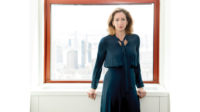Built in 1900, the gymnasium at Haverford College holds a prized location across from Founders Hall on the main quadrangle of the small liberal-arts school’s wooded campus, eight miles northwest of Philadelphia. Like many of the earlier buildings at the now nonsectarian institution, founded in 1833 by the Society of Friends, the beautiful stone structure reflects Quaker architectural principles of utility, balance, and simplicity. Its recent transformation into an arts hub reflects a complementary principle: first, do no harm.
Additional Content:
Jump to credits & specifications
Dressed in a rubblestone pattern of the local Wissahickon schist, which was repointed in the renovation, the three-story building features two protruding wings originally containing offices, an alumni lounge, and an attic filled with a treasure trove of century-old sports memorabilia and equipment discovered just prior to construction. A lower level had locker rooms and a swimming pool. The soaring central volume was used for any number of physical activities, including Swedish Gymnastics, popular on college campuses at the time the building was completed. Curiously—though not unheard of in older buildings—a suspended running track circles that main space, 12 feet above its floor.
Yet despite its noble presence and prominent position, the building met with a lamentable fate. As the gamut of athletic and sporting activities moved to modern facilities farther south on campus, the little edifice, known for years as Ryan Gym, was abandoned, becoming nothing more than an unkempt hangout for students. With a nascent plan for a new interdisciplinary arts curriculum to take over the building, the college brought MSR Design on board six years ago to help with programming for what would become the Visual Culture, Arts, and Media (VCAM) building. The Minneapolis-based firm—known for adaptive-reuse projects such as the transformation of shipbuilding facilities in Philadelphia’s Navy Yard into a corporate campus for Urban Outfitters—was eventually hired to execute the design.
Initial plans for an addition were scrapped for budgetary reasons. “In hindsight, that was the best thing that happened for the project,” recalls project manager Dagmara Larsen. So MSR chose a tack similar to the one it used in repurposing a Venturi, Scott Brown and Associates building into a new home for Drexel University’s College of Media Arts and Design. There, MSR maintained the colorful mosaic facade but radically altered the interior. Here, the firm also left the exterior largely intact, restoring the slate shingle roof and copper cupola, and made its big move inside, creating a multilevel insertion—a self-contained vessel, in a sense—within the central volume.
The gym’s wood floor was almost entirely removed to make way for the new construction, but its planks—many covered with basketball court markings—were saved and playfully rearranged as the ceiling for the lower-level “makerspace,” for instance.
The rather straightforward 5,130-square-foot insertion contains a screening room on its lower level; a film-editing lab and equipment storage above that; and a large room for film production and object study next to offices at the top, with elevators to connect them all.
But it’s the way those spaces in the new block interact with the rest of the building that makes the project sing. While at first there was some doubt about maintaining that idiosyncratic suspended track, it prevailed. Reinforced, and its surface made even, it is a highlight of the project, serving as circulation around the upper level, where faculty offices now line the north side of the building. It also doubles as a viewing platform when films are screened against the west wall of the insertion’s uppermost level. In fact, one can see clear up to those screenings, and into the film-production/object study room, through its large window, from the lower level—and that’s the point.
While visual access to all the different rooms was key for the cross-disciplinary nature of the activities taking place inside, acoustic separation was just as critical. White baffles were installed on the underside of the roof. Storm windows were added over original glazing. Graphic felt coverings beside those openings also absorb sound, and slide over the windows to block daylight for screenings.
Lots of elements serve double duty within this limited envelope, or were repurposed. The makerspace, positioned just over the now filled-in pool (it was previously only decked over), is also the loading dock. Original lockers now form the base of a large desk at the entry to the storage room. The insertion’s top floor has become a popular space for symposia across departments, since the college has limited similarly sized spaces for gatherings.
Haverford’s 216-acre campus has the distinction of being an arboretum. This project not only restored the building but improved the historic grounds. Unsightly squash courts behind the building were removed, creating space for a new green and allowing more direct north–south circulation across campus through VCAM. When a fire escape was moved, great care was taken in positioning its footings to avoid tree roots.
There were some on campus who mourned the loss of the building’s shabby, ad hoc former self. The new VCAM, however, with its community kitchen and 24/7 access, has become a campus hub. MSR’s thoughtful intervention maintains a level of that old Quaker sobriety but adds a touch of warmth— all without sacrificing the quirk.
CreditsArchitect: MSR Design
Engineering: Bruce E. Brooks & Associates (m/e/p); Keast & Hood (structural); Nave Newell (civil)
Consultants: Keystone Preservation Group (preservation); LaSalle Engineering (code, fire protection); Gallina Design (lighting); Threshold Acoustics (acoustics, AV); WC Consulting (specifications)
General contractor: Whiting Turner |
SpecificationsMasonry Zavorski Masonry Restoration
Slate shingles Greenstone Slate
Acoustical ceilings and suspension grid USG, Owens Corning
Metal doors Assa Abloy
Wood doors VT Industries
Custom woodwork Glick
Tile Appiani, Ann Sacks
Felted wall coverings Wolf Gordon
Auditorium seating Sedia Systems
Shelving Alias
Furniture Knoll, Allermuir, Vitra, Tolix, Emeco, Muuto, Leland, Andreu World, Haworth, Herman Miller, Artless, Rypen |
















Post a comment to this article
Report Abusive Comment